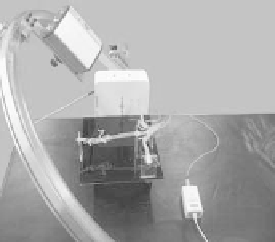Biomedical Engineering Reference
In-Depth Information
vasculature offers a suitable environment for simulation. Sub-clavian
and common carotid arteries were represented by a membranous
silicone model mounted on an acrylic stand. This silicone model was
built based on three-dimensional data of human arteries shown in
Fig. 7.5(a). The lumen of the silicone model was illed with air and
the surface of it was covered by surfactant (Figs. 7.5 and 7.6).
c)
Magnetic
Tracker
Silicone
Model of
Vasculature
10
m
m
a)
b)
Figure 7.5
(a) Three-dimensional data use for modeling sub-clavian and
carotid arteries. (b) Silicone model and MMCS placed over the
DSAP for robot manipulation evaluation. (c) Image captured by
the DSAP simulating endovascular surgery.
7.3.2 Magnetic Tracker
For controlling robots designed for endovascular surgery
applications, Aurora (Northern Digital Inc.) with a catheter shaped
micro coil with 5DOF (
X
,
Y
,
Z
, Yaw and Pitch) offered the most suitable
tracking solution. The micro coil size is 0.8 mm diameter and 8 mm
long and is embedded in to a 5F catheter. The physical properties
of this magnetic tracker enable moving it inside silicone models of
vasculature. The listed error by the manufacturer is 1.3 mm RMS in
a working space of 500
mm
×
500
mm
×
500
mm. The magnetic ield
emitted by the transmitter of the sensing system is not oscillating;
therefore, it minimizes Eddy currents allowing the use of it near
stainless steel SUS300.
7.3.3
Controller Design
To evaluate robotic camera manipulation with magnetic trackers,
a sparse LUT
M
0
was designed with vectors
P
n
, using the method
proposed in the previous section:





















































Search WWH ::

Custom Search